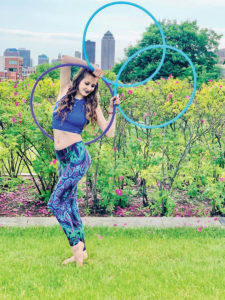That girl is on fire!
9/2/2020
Jessica Short uses her hula hoop to do flow artistry. She says locals of all ages and types enjoy the practice because “movement is for everybody.” Photo submitted
If you’re in northwest Des Moines and somewhere near Beaverdale or Drake University, and if you happen to see a flaming hula hoop spinning around a performer who is being cheered on by her neighbors while they snap photos, then you will have met Jessica Short — also known as the Holisitic Hooper on Facebook. The 27-year-old’s passion for hooping ignited seven years ago at a house party.
“A girl had a light-up hoop,” she remembers. “I instantly fell in love.”
That love led to daily practicing, usually for two hours or more during her first year. The hooper’s confidence grew and so did her muscles, stamina and endurance.
“I’m a severe asthmatic with one lung,” she says. “I can’t really do a whole lot of cardio and heavy exertion things, but hooping has been one of those exercises where I can move it to different parts of my body when I start to tire out. It has brought me a lot of peace and centering. It’s a form of mood-moving meditation for me. Meditation is a very big part of my life.”
A growing number of flow artists are thriving in central Iowa.
“Flow art is its own movement community,” says Short. “You’re using props and object manipulation with movement. Literally, you learn tricks, but it’s flowing in the moment. I don’t really choreograph, it’s all just… go with the flow.”
Local hoopers range from ages 4 to 90, according to Short, and both genders enjoy the practice.
“Movement is for everybody,” she explains.
The self-proclaimed “hoopsmith” gives back by offering workshops, in-person lessons and online instruction. You can find her on Facebook, Instagram and YouTube under: HolisticHooper.
“You can do more than you think,” she assures. “It takes just putting yourself out there and trying.”
Short also makes custom-made hula hoops to sell, and she brings the extras along with her to performances so others can hoop, too. People can be easily discouraged if they don’t have a proper hoop in their hands. Size matters, according to Short, the bigger the hoop, the slower it will rotate, and the slower the rotation, the more control a person has. The tube’s material makeup is also important.
“The higher density, the more of a beating it can take,” she explains. “Most children’s hoops are made with only a thin layer of plastic that tends to bend and break easily.”
Short’s fire-hooping shows happen when she feels like entertaining. After attaching wicks to the hoop’s exterior, it is her time to shine and let the sparks fly.
“The neighbors usually will hear the music starting and come out, or sometimes I’ll go running up the street and tell them, ‘Hey, I’m about to light up or about to flow.’ ” she says. “They usually will stay across the street if it’s fire. If it’s an LED hoop or plastic, then they’ll come nearer. They usually have their cameras out, and they’re cheering.”
Playing with fire demands a limited arsenal of tricks, and the show can only last as long as the wicks continue to burn, usually 4-5 minutes, but it’s spectacular to see.
“It’s very beautiful to watch,” she says. “For me, it’s very ceremonial. It’s a way for me to release, and I love fire. So I use it as also a form of meditation. I most commonly do it for the full moon and the new moon.” ♦




















